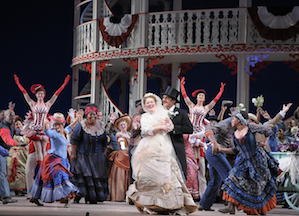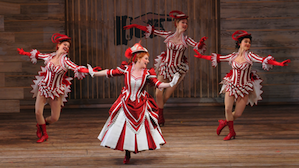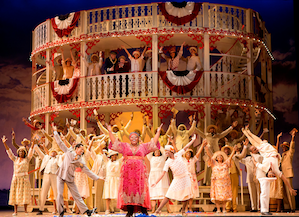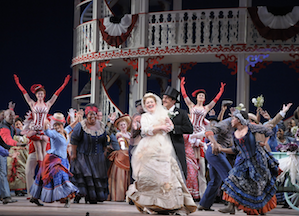
Photo by Dan Rest/Lyric Opera Chicago
San Francisco Opera's premiere of the Jerome Kern-Oscar Hammerstein II Show Boat on June 1 is an event that goes far beyond "just another opera." For starters, of course, it is not an opera, but — according to most — a musical.
SFO General Director David Gockley, who has a significant history of his own with Show Boat, is convinced that it is "an American operetta" that belongs to opera houses along such standard operatic fare as Die Fledermaus, The Merry Widow, and the work Gockley made routinely acceptable for operatic treatment: Porgy & Bess.
"Dyed-in-the-wool European-oriented devotees," Gockley says, initially oppose Show Boat presented as an opera, but once they see it with a mix of operatic and Broadway voices, there is acceptance ... and more.
Gockley speaks from experience. Back in 1982, his Houston Grand Opera restored much of the 1927 score and dialogue, toured the production in the U.S., presented it on Broadway, recorded an EMI best-seller, and took the work to Cairo for the inauguration of the Cairo National Culture Centre.
Beyond that, there are two sets of historical consideration. One, the subject and nature of "both a poignant love story and a powerful reminder of America’s bitter legacy of racism" about life on the show boat Cotton Blossom in the 1880s.
The second issue is the treatment, development, alteration of the work against changing sensibilities through the decades.

Photo by Robert Kusel/Lyric Opera of Chicago
Against the old days of big-budget Broadway productions, Gockley said:
In this day and age, only opera companies command the resources necessary to give a grand work like Show Boat its artistic due. The commercial theater sector, which gave birth to it and many others of its genre, simply cannot afford to remount these works on their terms.The original orchestrations called for an orchestra of 50, two choruses, dancers, and a large cast of principals. As a top tier opera company, we are able to present this work the way Kern and Hammerstein intended it, and we are able to cast the type of rich, legitimate voices required to give it its luster.
San Francisco Opera presented an extensive discussion this week of the work with a panel consisting of Gockley, stage director Francesca Zambello, conductor John DeMain, soprano Heidi Stober (Magnolia), and Bill Irwin, introduced as making his SFO debut in the role of Captain Andy.
"I don't know how far back do you go with the company," Irwin challenged the moderator, SFO Director of Music Administration Kip Cranna, "but I made my debut here in 1978."
Raised eyebrows all around. Yes, Irwin said, he was one of the acrobats behind Montserrat Caballe as she descended the stairs in the title role of Turandot — "leaning on two dwarfs," Zambello added correctly. (This was the legendary Jean-Pierre Ponnelle production with Caballe and Luciano Pavarotti; Prince Charles attended the premiere.)
Cranna — who joined the company in 1979 — acknowledged Irwin's seniority, and asked Zambello and DeMain about their experiences with this production, which they have headed in Houston, Washington, and Chicago during the past couple of years.

Photo by Scott Suchman/Washington National Opera
Zambello and DeMain spoke passionately of the score, beyond the well-known numbers of "Ol’ Man River," "Can’t Help Lovin’ Dat Man," "Make Believe," and "You Are Love." They agreed with superlatives about the composer, once called "the American Mozart." DeMain said the "gorgeous score" has been restored in a big way after Broadway and film treatments played havoc with the music.
DeMain said the original score ran 4 1/2 hours, with substantial portions cut in the years of "hodge-podge" orchestrations. Musically and dramatically, of the various film versions, DeMain strongly prefers the first one (after the original 1927 silent film), released in 1936, with Irene Dunne, Helen Morgan, and Paul Robeson.
Zambello spoke of the historic background, the work's bold use of a Caucasian and an African American chorus, asking "what it must have been like when [black] cast members couldn't have their own family in the audience," and the "tangible, palpable tension of dealing with an interracial marriage many years before it became legal" [in 1967].
Asked about the controversial, often censored, use of the N-word in Show Boat, Zambello said this production has "colored folks" in the lyrics. In the original text the N-word is kept when "used by the really bad characters because it's part of history in this exploration of racism," but not included in the Supertitles, which are not used anyway for spoken text.
As to the mix of opera singers, actors, dancers, the large cast must reach beyond individual comfort zones, which in case of Stober in the lead role of Magnolia means adjusting her operatic voice to those coming from (the unfortunately amplified) music theater, and add dancing to her repertoire ... and playing guitar. (There is "minimal, absolutely necessary amplification" in this production, Gockley said.)
There is at least one cast member for whom mixing genres is never a problem: Patricia Racette, in the brief but crucial role of Julie, has given us many years of diva-dom and striking stage presence.

